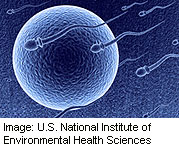
THURSDAY, April 17, 2014 (HealthDay News) — Scientists report they have demystified how a sperm and egg couple, with new research in mice indicating that egg cells carry a special receptor that allows sperm to attach to and fertilize eggs.
The British study, published online April 16 in the journal Nature, may offer new ways to improve both fertility treatments and contraceptives in people, with experts saying that human eggs also have protein receptors crucial to the meeting of sperm and egg.
A similar protein receptor was found on sperm in 2005 by Japanese researchers, who dubbed it Izumo1 after a Japanese marriage shrine. The newly discovered egg receptor has been named Juno after the Roman goddess of fertility and marriage.
“The finding that the interaction between Izumo and Juno is essential for fertilization was, in a way, surprising,” said study author Gavin Wright, group leader of the Cell Surface Signalling Laboratory at the Wellcome Trust Sanger Institute, a genome research institute in the United Kingdom.
“One might have expected that something as fundamental as fertilization would not rely on a single critical interaction; if there’s anything wrong with Izumo in males, or Juno in females, then infertility results,” Wright added.
About one in eight American couples suffers from infertility, defined as being unable to conceive after one year of unprotected sex, according to the infertility association RESOLVE. The problem may be due to male or female factors such as low sperm count or ovulation disorders, among other issues.
But even when infertility is treated with measures such as in vitro fertilization, where a couple’s sperm and eggs are mixed in a petri dish, fertilization will still sometimes fail to take place unless a sperm cell is injected into the egg in a procedure known as intracytoplasmic sperm injection (ICSI).
Wright said this problem may be due to a faulty or absent receptor on egg or sperm cells, as evidenced by his new research.
“Our results would suggest that by using a simple and noninvasive genetic screening test, infertile women could be tested to see if they have a correct Juno gene,” he said. “If they don’t, their fertility treatment can be guided by proceeding directly to ICSI, saving them expense and trouble.”
Wright and his team built on the Japanese Izumo1 research, creating an artificial version of the Izumo protein and using it to identify binding partners on the surface of mice eggs. Using this method, they learned that Izumo1 on the sperm paired with Juno on the egg to induce fertilization.
The researchers also developed mice that lacked the Juno protein on their egg surface, finding these mice to be infertile and incapable of fusing with normal sperm. Similarly, male mice lacking the Izumo sperm protein are also infertile, highlighting the vital roles of the receptors to fertility.
An interesting feature of the Juno egg receptor, Wright said, is that it disappears within about 40 minutes after an egg is fertilized.
“We believe this is one of the ways in which eggs ensure that they fuse with one and only one sperm,” he said. “That is, once the first sperm has fertilized the egg, the egg shuts down its ability to recognize additional sperm, ensuring that the fertilized egg doesn’t contain too many chromosomes, which would result in a non-viable embryo.”
Dr. Michael Heard, a reproductive endocrinologist at Houston Methodist Hospital in Texas, lauded the new research as “very interesting” and said the findings hold promise for future fertility treatments and contraceptives.
“A male contraceptive is still on the back burner. If they could inhibit those [Izumo1 sperm] receptors so they wouldn’t fertilize the eggs at all, with a high percentage of reliability, that would be great,” said Heard, who wasn’t involved in the study.
Scientists note that research involving animals often fails to provide similar results in humans.
More information
The American Society for Reproductive Medicine has more about infertility.
Copyright © 2025 HealthDay. All rights reserved.

